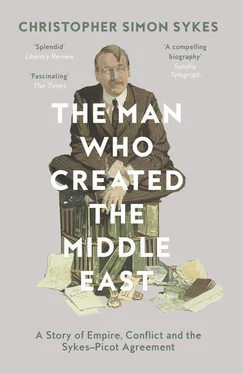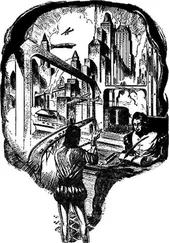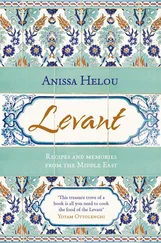‘At first I thought the hill was only a mass of lava and sand,’ Mark wrote in his report, ‘but on closer examination I found that it was a huge mass of bones and lava caked with bones. It was infested with snakes; I myself saw four gliding through the bones. When I had taken some photographs and secured some specimens of the rock and bones, we started on our return … I can say on excellent authority that I am the first European who has visited this place.’ 13When Mark eventually submitted his findings to the Palestine Exploration Fund, they concluded that the bones were probably the remains of a herd of domestic animals that had been caught in a volcanic eruption.
To have travelled to places where few Westerners have ever set foot and to have made a ‘discovery’ must have seemed the greatest of excitements for a young man of twenty, and it was undoubtedly one of the catalysts that gave Mark a life-long fascination with what would come to be generally known as the Middle East. He returned to Cambridge with a large supply of Turkish cigarettes, a Damascus pariah dog named Gneiss, an assorted array of Oriental headgear and a desire to share his experiences with anyone who would join him in his rooms, usually sitting cross-legged on the floor puffing away at a hookah . He lectured to the Fisher Society, and to the Cambridge Society of Antiquaries, as well as writing up an account of his travels for the Palestine Exploration Fund. He was planning his next trip when he received an important letter. ‘I have just heard from the Royal Geographical Society,’ he wrote to Henry Cholmondeley in the autumn, ‘to tell me that my discovery in Syria is of the greatest importance. My tutor has in consequence given me leave to stay down next term if I go abroad. I have every reason to believe that I shall find some extraordinary things in the Safah, the place where I discovered the “Hill of Bones”. I am the first person who ever entered the place. This was merely because for some reason the natives like me.’ 14
Mark was in high spirits when around this time he received an invitation to lunch at Howes Close, the Cambridge home on the Huntingdon Road of the local Conservative MP, Sir John Eldon Gorst. Gorst, who served as Vice-Chairman of the Education Committee in Lord Salisbury’s government, was the father of Jessie’s former lover, Jack, as well as another son, Harold, and five daughters, Constance, Edith, Eva, Gwendolyn and Hylda. This large and affectionate family welcomed in Mark, who, as an only child, was quite unused to the warm and friendly atmosphere they generated with their in-jokes and humorous banter, but he quickly fell under their spell. He too entranced them, regaling them with tales of his adventures, acting the part of the individual characters in each story.
Sunday lunch at Howes Close became a regular outing for Mark, not least because he found himself increasingly attracted to Edith, the middle of the five girls. Twenty-six years old, tall and handsome, with soft features and thick chestnut-coloured hair, she was, like him, a convert to Roman Catholicism, and their mutual devotion to their religion became the basis for, first, a firm friendship, and then a growing attraction. She was also an accomplished horsewoman and since Mark also had a horse stabled in Cambridge, they took to going riding together. After the intrigues and machinations of his mother, Edith’s down-to-earth approach to life came like a breath of fresh air. ‘I really like [you],’ he told her, ‘really and truly and not in any way tinged with that ridiculous, maudlin, drivelling, perverse folly that idiots call “being in love”. I like you because you are honest and unselfish, because you are the only truly straightforward person I have ever met.’ 15
Edith’s emotional support was doubly important in the light of his mother’s situation. She was at her lowest ebb. Her friends had all dropped her. She could not approach her brothers, who were all respectably married with families, while her younger sister Venetia, married to an American millionaire, Arthur James, and one of Society’s leading hostesses, considered that she had disgraced herself beyond measure and would have nothing to do with her. She had been turned out of the house in Grosvenor Street and, to cap it all, in December 1898 she suffered the death of her beloved brother-in-law, Christopher, who had been one of the few people to stand by her through all her troubles. Mark decided that before he left on his next journey, he would make one more effort to persuade his father and his lawyers to reach a final settlement with Jessie. ‘Dear Cousin Henry,’ he wrote to Cholmondeley, ‘… would you try & get a meeting arranged between yourself, my father, Gardener [ sic ] and I at Gardner’s [ sic ] office, this is the last chance of a settlement, & worth trying, my mother is really broken and would accept any reasonable terms. I hope I can trust you to arrange this meeting as after that I should feel quite unresponsible for any further disgraces & that I had done all possible to stop it …’ 16
Confident that he had set the wheels in motion to try and help his mother, he prepared to set out for Syria. On the eve of his departure he went to mass in Cambridge to take one last look at Edith, an event which reinforced his feelings for her. ‘If you knew the agony of mind I went through,’ he wrote to her on his return, ‘… when I saw you leave the church and I went away without a word, if you knew how I felt that day, how I shook as if with an ague, with dry mouth and trembling steps, how I watched you go away further and further, and by quickening my steps I could have caught you up and didn’t for fear that you might have some small inkling what was in my mind before I chose you should, because I thought to myself, perhaps I am only in love …’ 17
Mark left for Syria on 14 December, intending to return to the Haurân in the hope of making more discoveries, but things did not work out quite the way he had hoped. The country was divided into three districts, or Wilayets : Aleppo in the north, Beirut in the west and south, and Damascus, which embraced the whole country east of the river Jordan. Each of these was governed by a Wâli, and was in turn divided into districts which themselves were governed by more officials. No progress could be made by the traveller without a series of permissions, the issue of which was by no means certain, often leading to days or even weeks of delays. For some reason, ‘difficulties arose’ and Mark was refused a permit by Nazim Pasha, the Wâli of Damascus, to visit the Haurân. Instead, he decided to travel to Baghdad by way of Aleppo.
The party left Damascus on 17 January. ‘I took with me,’ wrote Mark, ‘a dragoman, a cook, a waiter, four muleteers, and a groom; seven Syrian mules … two good country horses for myself and one each for the cook and the waiter; a Persian pony for the dragoman; and last, though not least, a Kurdish sheepdog that answered to the name of Barud, i.e Gunpowder, and not only attended the pitching and striking of the camp but after nightfall undertook the entire responsibility of guarding it.’ 18Of the attendants, including Michael Sala, the cook, and Jacob Arab, the waiter, by far the most important was the dragoman, a Cypriot Christian called Isá Kubrusli, whose job was to act as interpreter and guide. A striking-looking man with piercing eyes, he had worked as a dragoman for forty years, in which time he had served a number of important Englishmen, notably Sir Charles Wilson on his expedition to locate Mount Sinai in 1865, and Frederick Thesiger in the Abyssinian Campaign of 1867–8, ‘Thirty years ago,’ Mark wrote, ‘a dragoman was a person of importance; a man similar in character to the confidential courier who in the last century accompanied young noblemen on the Grand Tour. But he has degenerated and for the most part is now simply a bear leader, to hoards [ sic ] of English and Americans who invade Syria during the touring season.’ 19
Читать дальше











